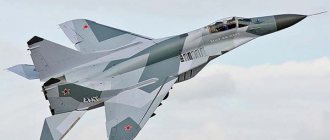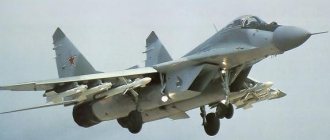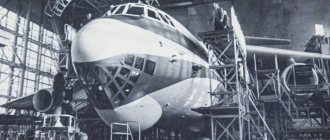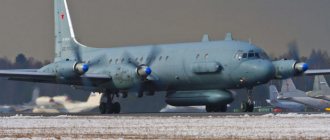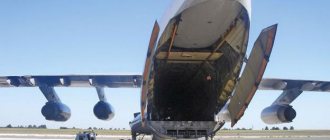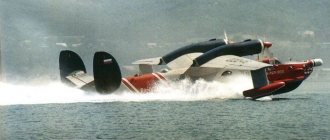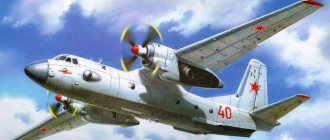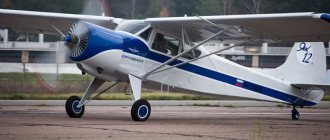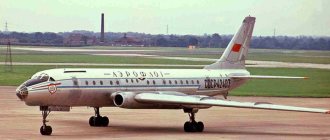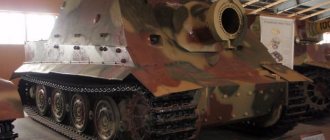In the late 90s, to ensure effective counteraction to NATO submarines, Russian designers began work on modernizing the Il-38 aircraft. The new modified aircraft model received the designation Il-38N.
The modernized aircraft entered service with the Russian Navy in the 2000s and was rightly called by the Americans a “submarine killer.” The article provides a description of the anti-submarine aircraft, its technical characteristics and weapons.
Developer
The Il-38N project was carried out at the Design Bureau of S.V. Ilyushin. The essence of the work was to modernize the existing Il-38.
This aircraft was once created at the Ilyushin Design Bureau on the basis of the passenger Il-18V as part of the Tuna project. This model was produced from 1967 to 1972. During this time, 65 such aircraft were assembled. Il-38 has been in service for almost 50 years. This is considered a considerable service life of an aircraft unit. In this regard, some military experts assumed that after such a long operation, the Il-38 would be cut into scrap metal or handed over as an exhibit to a museum. However, the aircraft uses very high-quality “filling” and a reliable airframe. During all the years of service, only two flight accidents occurred with the Il-38, the cause of which was the human factor. Now the designers have decided to improve the IL-38 as much as possible, equipping it with a new search and sighting system and extending its operational life by 15 years. Simultaneously with the modernization of the aircraft intended for the Russian Navy, the Ilyushin Design Bureau was designing a similar aircraft model for the Indian Navy: the Il-38 SD. Russian specialists have modernized six basic models of the Il-38. The aircraft were re-equipped and handed over to the customer in 2010. At the moment, there are already four Il-38 SD serving in the Indian Navy.
Flight performance
The Il-38 is often compared to the American Orion aircraft, which has been in service since the early 60s. The comparison is not very accurate, but the domestic car does not have a closer foreign analogue.
| IL-38 | P-3 Orion | |
| Length, m | 40 | 35 |
| Wingspan, m | 37 | 30 |
| Maximum speed, km/h | 650 | 750 |
| Combat radius, km | 2200 | 2371 |
The reason why Orion is not a complete analogue of the IL-38 is simple. It was created within the framework of precisely the concept that the creators of the domestic torpedo bomber objected to. The Orion is a multi-role patrol aircraft equipped with a wider variety of equipment. Unfortunately, this equipment was also superior to Soviet equipment in terms of perfection.
Despite problems with the modification of radio-electronic equipment, the Il-38 gained recognition and respect among naval aviation pilots.
Although the Tu-142 “pulled off” a more prominent role, the “thirty-eighth” survived the most difficult years and continues to improve.
Tests
The IL-38N with a red tail number was tested for the first time in April 2001. The aircraft was controlled by crew commander V.M. Irinarkhov and assistant commander, Honored Test Pilot of Russia V.I. Butov. A few years later, the anti-submarine aircraft with a yellow tail number was sent for re-testing. Tests were finally completed in 2012. The modernized Il-38 was transferred to the needs of the Russian Northern Fleet. As of today, information about the use of this aircraft unit is not publicly available.
About the system from JSC Leninets
The improved IL-38N differs from previous models by the presence of a new search and targeting system, which gives it significantly expanded capabilities. The basis for this system was the export model Sea Dragon (“Sea Serpent”), which was started by American aircraft designers back in 1962. The Russian version is listed as the Novella-P-38 system. Upon receipt of the order from the Ministry of Defense, Russian designers decided to equip the old Il-38 with this search and sighting system. Thanks to the introduction of this system, it became possible for the Il-38N aircraft to detect air targets at a distance of up to 90 thousand meters. In addition, the modernized Il-38 is capable of monitoring 50 surface objects within a radius of no more than 32 thousand meters. The position of the targets does not affect tracking efficiency.
Cabin structure
The search and sighting system is controlled from the IL-38N cockpit with the participation of two operators. The cabin is equipped with two automated workstations.
Operators are provided with two LCD color multifunction screens, a control panel and a keyboard. The screens depict the tactical situation and a digital navigation map.
System components
The Novella-P-38 installation is a navigation sighting and search system. The system consists of the following components:
- High resolution radar system.
- Telethermal imaging system "Lanner-A" with laser, television and thermal imaging channels, for which gyroscopic stabilization is provided.
- Radiohydroacoustic system.
- Magnetometric system.
- Command-tactical.
- Systems responsible for electronic intelligence.
Exterior design
The fuselage of the modernized Il-38 is dark gray. The aircraft's tail number is indicated in yellow numbers. The IL-38N is equipped with new attachments, which is an RTR system that carries out electronic reconnaissance.
The location of the attachments was a special container above the fuselage. There is an assumption that the RTR system will be used in the future to maintain communication with the RTR Liana maritime space reconnaissance and target designation system. However, the reliability of this information, which became known to the media, has not yet been verified.
The location for the search and survey system is the forward part of the fuselage. A special spherical container has been developed for the system.
History of operations[edit]
An Il-38 May flew low over the USS Midway on May 18, 1979.
One prototype was lost in the early 1970s when it had to be abandoned at sea. [1]
The Il-38 was operated by units of the Soviet Northern, Pacific and Baltic fleets. In March 1968, a squadron of Il-38s was sent to Cairo in Egypt, flown by Soviet crews but with Egyptian markings until withdrawn in 1972. Il-38s continued to be deployed overseas during the Cold War, flying from Aden in South Yemen to Asmara. in what was then Ethiopia, Libya and Syria. Two Il-38s were attacked by ground forces in a sabotage raid, and at least one was destroyed by Eritrean People's Liberation Front fighters in 1984 in Asmara. [3]After the end of the Cold War and the collapse of the Soviet Union, Il-38s continue to serve in the Arctic and Pacific fleets of the Russian Navy. [5]
This type made its first visit to a NATO base in 1995 at NAS Jacksonville, USA. [1] His first appearance at an air show in the West was in 1996 at the Royal International Air Tattoo in the UK. [1]
The tragic plane crash occurred on October 1, 2002, during the Indian Squadron's silver jubilee celebrations. IN302 and IN304, flying parallel to each other, collided in mid-air over Dabolim Airport in Goa. All twelve crew (six on each aircraft) were killed and both aircraft were also destroyed. [8]
About weapons
For the combat version of the modified Il-38, the following are provided:
- Anti-submarine depth charges.
- Radioacoustic buoys of various types. The total number of buoys does not exceed 150 units.
- Torpedoes AT-1 or AT-2 and APR-2.
- Illumination aerial bombs.
- Sea mines.
The additionally improved Il-38 can be equipped with air-launched Caliber-A missiles, the flight range of which is 5 thousand km. The payload for which the anti-submarine aircraft is designed is no more than nine tons.
Literature
- Artemyev A.
“Tuna” goes hunting. About the Il-38 anti-submarine aircraft (Russian) // Wings of the Motherland. - M., 2000. - No. 10. - P. 1-7. — ISSN [www.sigla.ru/table.jsp?f=8&t=3&v0=0130-2701&f=1003&t=1&v1=&f=4&t=2&v2=&f=21&t=3&v3=&f=1016&t=3&v4=&f=1016&t=3&v5 =&bf=4&b=&d=0&ys=&ye=&lng=&ft=&mt=&dt=&vol=&pt=&iss=&ps=&pe=&tr=&tro=&cc=UNION&i=1&v=tagged&s=0&ss=0&st=0&i18n=ru&rlf=&psz =20&bs=20&ce=hJfuypee8JzzufeGmImYYIpZKRJeeOeeWGJIZRrRRrdmtdeee88NJJJJpeeefTJ3peKJJ3UWWPtzzzzzzzzzzzzzzzzbzzvzzpy5zzjzzzzzzzzzzzzzzzzzzzzzzzzz zzzzztzzzzzzzbzzzzzzzzzzzzzzzzzzzzzzzzzzzzzzzzzyeyTjkDnyHzTuueKZePz9decyzzLzzzL*.c8.NzrGJJvufeeeeeJheeyzjeeeeJh*peeeeKJJJJJJJJJmjHvOJJJJJJJJfe eeieeeeSJJJJSJJJ3TeIJJJJ3..E.UEAcyhxD.eeeeeeuzzzLJJJJ5.e8JJJheeeeeeeeeeeeyeyeK3JJJJJJJJ*s7defeeeeeeeeeeeeeeeeeeeeeeeeSJJJJJJJZIJJzzz1..6LJJJJJJtJJZ4….EK*&deb ug=false 0130-2701]. - Artemyev A.
Il-38 against missile submarines. - Moscow: "Major", 2002. - 60 p. — 900 copies. — ISBN 5-93445-007-9.
About purpose
At one time, the IL-38, independently or together with ships, performed the following tasks:
- Search and destroy enemy submarines.
- Conducted maritime reconnaissance and search and rescue operations.
- With the involvement of Il-38, minefields were installed.
According to experts, the appearance of IL-38 off the coast, even at a great distance, has a tangible psychological impact on a potential enemy. To do this, it is sufficient to carry out scheduled flights without violating the rules for the use of airspace. A striking example of this is the disruption of the US-Japanese exercises in 2010. Both sides feared that a Russian Il-38 tuned to their radar frequency could intercept top-secret information. For this reason, the military maneuvers of the United States and Japan were curtailed.
As a result of the modernization (see above), the combat capabilities of this anti-submarine aircraft were increased fourfold. Thanks to the introduction of components of the new search and targeting system, it became possible to use the improved Il-38 to solve various military tasks, including the detection of underwater and surface targets, as well as the rapid destruction of submarines using depth charges. Depending on the combat mission, the composition of the equipment may change. The aircraft is capable of patrolling its assigned area for a long time. Having received the necessary information about the target, the Il-38N commander can transmit the received information to other aircraft or ships, as well as successfully attack the enemy independently.
The use of the aircraft is not limited only to the fight against enemy submarines. This aviation model is used to solve various national economic problems. Thanks to the presence of special sensors that make it possible to detect any gravitational anomalies, the modernized Il-38 is in great demand in oceanology, ecology, geological exploration, ice exploration, etc.
Today, with the help of the Il-38, equipped with the Novella-P-38 system, magnetic and gravitational maps of the Arctic Ocean are compiled.
IL-38 – MAY
DATA FOR 2016 (standard update)IL-38 - MAY Anti-submarine and maritime patrol aircraft. In August 1957, when the Il-18 passenger airliner was just being created, the Commander-in-Chief of the USSR Navy, S.G. Gorshkov, proposed using it to create a long-range anti-submarine aircraft with K-18 anti-submarine cruise missiles. The aircraft was supposed to be used to destroy enemy boats at a distance of 500-1000 km from its coast. In the same 1957, a Decree of the Council of Ministers of the USSR was issued on the development of such an aircraft based on the Il-18 airliner (Il-18PLO) or the An-12 transport aircraft. The draft tactical and technical requirements for the creation of an anti-submarine modification of the Il-18 aircraft were sent by the USSR Air Force to the OKB-240 GKAT USSR General Designer S.V. Ilyushin in 1957. The aircraft was supposed to be equipped with the first generation radiohydroacoustic system "Baku", which at that time existed in form of a project. The newly adjusted technical specifications for the aircraft were sent to OKB-240 in 1958. By Decree of the Council of Ministers of the USSR on December 11, 1959 No. 1335-594 SSKNII-131, the Ministry of Radio Industry of the USSR was entrusted with the creation of on-board equipment for a radiohydroacoustic search and detection system for the Berkut submarine. The creation of radiohydroacoustic buoys was entrusted to NII-753 of the USSR Ministry of Shipbuilding. The ideological foundations for the use of Il-38 aircraft were jointly prepared by the Naval Academy, a number of Navy and Air Force institutes.Il-38 of the Pacific Fleet aviation in Kamchatka, December 2013 (https://pressa-tof.livejournal.com).
Il-38SD of the Indian Navy, registration No. IN305, serial No. 080010609.
India, Goa, 04/03/2013 (photo - Vyacheslav Firsov, https://russianplanes.net/id103504). In flight Il-38 of the Northern Fleet of the Russian Navy, January 2012 (https://www.function.mil.ru). By Resolution of the Council of Ministers of the USSR on June 18, 1960 No. 640-261, OKB-240 GKAT was entrusted with the development of the Il-38 anti-submarine aircraft - the theme of the Tuna R&D project - with the Berkut submarine detection complex with the TsVM-264 on-board computer. It was decided to create the Il-38 aircraft on the basis of the already proven Il-18V. In 1960, the Il-18 aircraft was transferred from civil aviation to test equipment and ensure the development of the aircraft. The tactical and technical requirements for the aircraft were approved by the Air Force Commander-in-Chief on May 4, 1961. They were also signed by the Deputy Commander-in-Chief of the Navy for Armaments and the Deputy. Commander of the Navy Aviation, Lieutenant General of Aviation I.I. Borzov, appointed chairman of the state commission on the Il-38 aircraft. In accordance with the TTT, the Il-38 had to have the following data: - tactical radius - 2200 km - time spent in the area at altitudes from 500 to 2000 m with a load of 5850 kg for at least 3 hours - minimum permissible indicated flight speed - 350 km / h The first copies of the Il-38 without special equipment were planned to be presented for testing in the second and fourth quarters of 1962. R.P. Papkovsky was appointed chief designer of the Il-38. The development of the aircraft was carried out in the department headed by V.M. Germanov. The creation of the preliminary design was led by S.V. Ilyushin. The preliminary technical design of the Il-38 with the Berkut search and sighting system was protected by OKB-240 in 1961. The construction of the prototype was carried out at the OKB-240 pilot plant together with plant No. 30, which supplied ready-made components for the airframe and other systems. The first flight of the first Il-38 prototype without anti-submarine equipment took place on September 27, 1961 (pilot - V.K. Kokkinaki, co-pilot - E.I. Kuznetsov, navigator - V.F. Voskresensky, radio operator - I.S. Silimanov) . The mock-up commission for the Il-38 with the Berkut system took place from May 15 to June 12, 1962 in Moscow. Factory tests of the Il-38 are planned at the Kirovskoye airfield (Crimea) in the second quarter of 1962. Testing of the entire system was planned to begin on March 15, 1963. The second experimental Il-38 made its first flight from the M.V. Frunze Central Airfield in Moscow in September 1962. On March 10, 1963 (March 16, according to other data), the equipment of the Berkut search and targeting radar and radiohydroacoustic system was installed on the Il-38 aircraft for testing (with a delay of almost 1 year). Some of the equipment was tested on the Il-18 aircraft. At this stage of testing, 147 flights were carried out with 369 flight hours on the Il-38. Substantial assistance was provided by the crew of Major A.P. Sharapov from the 33rd center (navigator captain N.P. Surkov, navigator-operator captain Igonin). The reduction in testing time was also facilitated by the hydroacoustic range developed by the center’s specialists, engineer-lieutenant-colonel V.V. Achkasov, OK Denisenko and engineer-captain Magadeev - a modeling device that simulates the operation of non-directional and directional buoys with the development of the task of destroying submarines on a land range using bombs. In April 1964, testing of an aircraft fully equipped with equipment began. Stage “A” (first) of state tests was completed in August 1964. Joint tests under the program of the second stage, without presentation to the Air Force, continued from October 2 to November 28, 1964 (19 flights, flight time was 61 hours 40 minutes). They were carried out in accordance with the order of the Commander-in-Chief of the Air Force, the Chairman of the GKAT and the Chairman of the SCRE dated September 15, 1964. During this stage of testing, it was established that the Berkut system was not brought to an operational state. From December 1964 to April 1965, equipment that had expired was replaced, and new AI-20M engines were installed. State joint tests of the Il-38 with the Berkut system were carried out on the orders of the Commander-in-Chief of the USSR Air Force from June 6 to December 15, 1965. 87 flights were completed with 287 flight hours, including the development of the Berkut and magnetometer - 10 flights with 38 flight hours h 15 min. The aircraft was tested at the Kirovskoye airfield near the city of Feodosiya (Crimea). Test program in accordance with the instructions of the deputy. Chairman of the USSR Council of Ministers L.V. Smirnov dated February 8, 1965 and the joint decision of the Air Force, MAP and MRP dated March 3, 1965 was fully implemented. Tests of the Il-38 aircraft were carried out by test pilots of the 3rd Directorate of the 8th State Scientific Research Institute of the Air Force: senior test pilot Colonel Sukhinin, senior test pilot engineer Lieutenant Colonel Kuzmenko, from OKB-240 GKAT leading test pilot V.K. Kokkinaki, pilot- tester A.N.Tryulin. Test pilots Lieutenant Colonel Vlasenko and Major Stepanov and test navigators Lieutenant Colonels N. Moskalenko, Melekhin, Voronov, Major Litsman also took part in the flights. Based on the test results, List No. 1 of deficiencies was compiled, consisting of 96 points, which had to be eliminated before the aircraft began operating. The weight of the empty aircraft was exceeded by 2600 kg over the model data, the noise indicators inside the aircraft in flight were significantly exceeded above the requirements of OTT VVS-58, the reliability of the Berkut PPS was low. Back in 1962, the need for aviation of the USSR Navy for 250 Il-38 aircraft was agreed upon. Serial production of the Il-38 began at aviation (Moscow) in 1967 and continued until 1972. A total of 65 aircraft were built at the plant during this period. The Il-38 aircraft with the Berkut search and sighting system was adopted by the USSR Navy on January 17, 1969 after the Berkut PPS was refined and the deficiencies identified during testing were eliminated. Over many years of service, both in the USSR and abroad, the aircraft has established itself as an easy-to-maintain and reliable machine. The design is a classic low-wing aircraft with a straight wing. The aircraft was created on the basis of the Il-18V - there are two heated compartments in the fuselage to accommodate buoys, bombs and torpedoes. Due to a change in the alignment of the fuselage, the wing was moved three meters forward and, due to an increase in the amount of fuel, its design was changed. Due to the forward displacement of the wing, the noise level in the cockpit exceeded the norm by 28 dB and amounted to 118 dB. An additional fuel tank is installed in the fuselage, control of the aircraft and engines are located on the sides of the fuselage, and the design of many aircraft systems has been changed. The fuel system included wing tanks (including a caisson tank in the center section) with a capacity of 30,300 liters and fuselage tanks with a capacity of 4,200 liters. The Berkut radar antenna radome is located under the nose of the fuselage. Despite the reinforcement of the structure with a steel plate, when the aircraft landed on water, the radar fairing was demolished and destroyed part of the fuselage under the influence of the water flow. The crew is housed in a sealed cabin with a volume of 28 cubic meters. The cabin is located in the forward part of the fuselage up to the 10th frame. The crew boards and disembarks through a hatch in the lower part of the fuselage. There is a hatch on the fuselage roof for leaving the aircraft in case of landing on water. The aircraft's landing gear has been strengthened (compared to the Il-18). New anti-icing and oxygen systems and air conditioning units were installed. Engines: 1) project - 4 x AI-20 turboprop engines developed and produced by NPO Progress. Chief engine designer - A.G. Ivchenko. 2) Il-38 prototype No. 1 and No. 2 until 1965 - 4 x AI-20A theater engines developed and produced by NPO Progress. Chief engine designer - A.G. Ivchenko. 3) Il-38 since 1965, prototypes and series - 4 x AI-20M turboprop engines developed and produced by NPO Progress with a power of 4250 hp each. Chief engine designer - A.G. Ivchenko. The plane could continue to fly with two engines running. Since 1965, the aircraft has been equipped with a TG-16 auxiliary power unit (behind the rear cargo compartment). Aircraft performance characteristics: Crew : - 7 people (ship commander, assistant ship commander, navigator-navigator, navigator-radar operator, navigator-operator of the aircraft receiving and display device SPIU, on-board engineer, radio operator). - 10 people (export version - ship commander, assistant ship commander, navigator-navigator, three navigator-operators, navigator-operator of the aircraft receiving and display device SPIU, on-board engineer, radio operator and someone else). The workplaces of the operators of the Berkut PPS equipment are located with their backs facing the flight of the aircraft. Length - 39.6 / 40.07 m (according to various sources) Tail boom length with MA detector - 5.6 m Wing span - 37.42 m Height - 10.16 m Wing area - 140 sq.m Maximum fuselage diameter - 3.5 m Cockpit volume - 28 cubic meters .m
| Maximum take-off weight | 63500 kg | |
| Empty mass | 33700 kg | |
| Fuel mass (volume) | (34500 l) | |
| Payload weight | 5000 kg nominal 5620 kg norm | 5370 kg normal 8000 kg overload |
| Il-38 TTZ 1960 | IL-38 basic model | |
| Ferry range | 9500 km | |
| Maximum range | 7100 km | |
| Combat range | 2200 km | 2500 km |
| Maximum speed | 650 km/h | |
| Cruising speed | 350 km/h (minimum indicated speed in patrol mode) | 456 km/h |
| Practical ceiling | 100-200 m (using a magnetometer) | 10000 m |
| Duration of patrol | 3 hours at an altitude of 500-2000 m |
Armament:
| IL-18PLO project 1957 | IL-38 mockup | IL-38 basic model | Il-38 / Il-38SD (India) | |
| Artillery | 2 x 23 mm cannons in the rear gun mount | No | No | No |
| Missile weapons | anti-submarine cruise missiles with nuclear charge K-18 (2 pcs) | No | No | 2 x Sea Eagle or X-35 Uran anti-ship missiles |
| Torpedoes | up to 8 aviation torpedoes AT-1, AT-2 | 2 x anti-submarine torpedoes AT-1, AT-2, APR-1 | anti-submarine torpedoes AT-1, AT-2, APR-2, etc. | similarly |
| Bombs, etc. | Air bombs, anti-submarine atomic bomb "Scalp" | - 10 x PLAB-250-120 anti-submarine bombs or - 10 x PLAB-50 anti-submarine bombs or - 98 x PLAB-MK anti-submarine bombs or "Skalp" anti-submarine atomic bomb (initially excluded from the armament, later included) | - aviation anti-submarine - flare bombs (OAB) - markers | similarly |
| Mines | no data | 4 x mines IDGM / AMD-2M, APM, "Lira", "Serpey", RM-1 or 8 x mines IDGM-800 | similarly | similarly |
| Radio sonobuoys | supposed | supposed | — RSL-1 — passive non-directional action; — RSL-2 — passive directional; — RSL-3 — passive-active; | similarly |
Bomb weapons are placed in a special compartment in the fuselage or on suspension units on the sides of the fuselage. Placing suspended weapons under the wing of the basic IL-38 model is impossible due to the overload of the center section. Indian Il-38 aircraft have been converted under the Project Yaduvansh project to use Sea Eagle anti-ship missiles. Two missiles can be suspended on hardpoints on the sides of the fuselage just behind the center section. From the same pylons it is possible to use adjustable air buoys KAB-500-M62.
Sea Eagle anti-ship missiles under an Il-38 aircraft of the Indian Navy (photo - Indian Navy, from the archive of B.Harry, https://www.acig.org).
Sea Eagle anti-ship missiles under the Il-38 aircraft board No. 03 of the Indian Navy (photo - Indian Navy, Vijay Simha Reddy, https://www.bharat-rakshak.com).
Launch of the X-35 "Uran" anti-ship missile from an Il-38SD aircraft of the Indian Navy (https://www.bharat-rakshak.com).
IL-38 board No. 07 red and aircraft jet torpedo APR-2 "Yastreb-M". Elizovo airfield, Kamchatka, Air Fleet Day, 08/15/2010 (photo by A.A. Piragis, https://www.fotopetropavlovsk.ru).
Il-38 board No. 07 red and UMGT-1 torpedo. Elizovo airfield, Kamchatka, Air Fleet Day, 08/15/2010 (photo by A.A. Piragis, https://www.fotopetropavlovsk.ru).
Loading sonar buoy ammunition onto the Il-38 of the Pacific Fleet aviation, Nikolaevka airbase, July 2012 (photo - warlock_fe, https://warlock-fe.livejournal.com/).
Already at the stage of the preliminary technical design (1961), a decision was made not to equip the Il-38 aircraft with defensive weapons.
It is proposed in the future to equip the Il-38 with defensive all-aspect air-to-air missiles. The OKB's proposal was supported by the customer's representative (Navy) - Deputy. Commander of the Navy Aviation, Lieutenant General of Aviation I.I. Borzov. Equipment : - IL-38 : Search and targeting anti-submarine system "Berkut", leading designer - V.S. Shuneyko (later - A.M. Gromov). The creation of the system was carried out with delays at all stages of readiness of systems and equipment. When creating the system, there were also proposals from foreign companies to purchase radiohydroacoustic systems. In the summer of 1962, the research institute that created the system proposed an alternative version of the system. The proposal was initially rejected by the customer, but was later reviewed. To search for submarines, it was proposed to use RSL (buoys) of a simplified design without a channel for broadcasting hydroacoustic information. It was replaced by a radar beacon, which, upon reaching a certain noise level on the hydroacoustic threshold device, switched it to radiation mode. It was proposed to scatter such buoys in the area, and then, tracking the transponder beacons, take aim using the radar screen. Mathematical modeling showed that as the submarine moves, the buoys that come into operation form a certain figure at the center of gravity of which the location of the submarine is determined with an accuracy that ensures the use of weapons. Theoretically, everything was correct, but in practice such a theory is unacceptable: the crew did not have the opportunity to classify the contact received, the acoustic field of the submarine has a complex shape, not close to circular, as was customary. The theoretical development and proposal were considered interesting, but it was decided to continue the work in accordance with the previously received assignment. As a result, the detection of submarines was carried out using RSL-1 buoys with an accuracy of 3.4 degrees in azimuth and at a range of up to 60 km. The position and movement parameters of the target boat were clarified by RSL-3. Information from the RSL was processed by the on-board computer and displayed on the operator’s screen.
Cockpit of the Il-38 aviation of the Northern Fleet of the Russian Navy, January 2012 (https://www.function.mil.ru).
On March 10, 1963, the Berkut system equipment was installed on the Il-38 aircraft, and individual units not intended to solve problems in conjunction with other elements of the system were installed on the Il-18 aircraft. The delay in entering the tests was almost 1 year. Joint tests under the second stage program, without presentation to the Air Force, continued from October 2 to November 28, 1964. During this stage of testing, it was established that the Berkut system had not been brought to an operational state. Bringing the Berkut system to working condition took a total of 8 years. Submarine detection range - 30-35 km with sea waves up to 3 points (according to TTZ) MTBF - 6 hours (based on state tests) The system included: - Berkut radar (modification of the Initiative radar) in a fairing under the nose part of the fuselage; — magnetic anomaly detector; — radiohydroacoustic system "Berkut" - a system for collecting information from radiohydroacoustic buoys. — on-board computer TsVM-264 — through the on-board computer, the radiohydroacoustic system is connected to the flight navigation system;
Antenna radome of the Berkut radar under the fuselage of the Il-38 MAY, August 1986 (February 1985 (https://www.defenseimagery.mil).
An APM-60 Orsha aeromagnetometer is installed in the tail section of the aircraft.
A magnetometer was used to confirm contact with the submarine. In addition to solving anti-submarine missions, the Berkut system, together with the Put-4V-2K flight and navigation complex, the AP-6E autopilot and the ARK-B automatic radio compass, also provided automatic flight along the route and semi-automatic navigation in all flight modes except take-off and landing . Emergency rescue equipment - PNS-2 raft, sea rescue suits for MSK pilots. — Il-38SD / Il-38SD (Sea Dragon / “Sea Dragon”) - the aircraft is equipped with a new radar complex “Sea Dragon” developed and produced by NPO Leninets (St. Petersburg). The aircraft's equipment includes a Sea Dragon radar with digital processing of results, an electro-optical (IR + laser) surveillance system GOES-324, a new electronic radar system, a GPS / GLONASS navigation system and a magnetic anomaly detector. Two workplaces for surveillance system operators are equipped with 13″ LCD monitors, the third workplace for a senior operator is equipped with a larger display. Radar detection range: - sea targets, ships - 320 km - aircraft - 90-100 km Number of simultaneously tracked targets - 32 - Il-38N (Novella-P-38 complex) - aircraft for Russian Navy aviation, equipped with a new radar system "Novella-P-38" developed and produced by NPO "Leninets" (St. Petersburg). The complex includes a digital digital computer, two operator stations, a high-resolution TV system, a magnetometer, optical sensors of various types, etc. The Il-38N made its first flight on April 4, 2001 (crew commander, Honored Test Pilot Vladimir Mikhailovich Irinarkhov). In 2015, Aviation Complex named after. S.V. Ilyushin completed a state contract for the repair and serial modernization of the first batch of Il-38 anti-submarine aircraft of the Naval Aviation of the Russian Navy to the level of Il-38N (source). Detection range of surface targets - 320 km Modifications : - Il-18PLO - anti-submarine aircraft with K-18 anti-submarine cruise missiles. The creation of the aircraft was proposed by the Commander-in-Chief of the USSR Navy S.G. Gorshkov in August 1957 - Il-38 - MAY - basic patrol and anti-submarine aircraft; — Il-38 experimental with refueling — the first production Il-38 aircraft (serial number 10106) tested the in-flight refueling system. A pylon was installed along the fuselage to hang the UPAZ container, and a refueling rod was installed on the fuselage.
Il-38 board No. 10, the first production one.
On the fuselage you can see traces of the installation of a refueling system, Lugansk, Ukraine, 05/11/2008 (photo - Oleg Vafin, https://russianplanes.net). — Il-38SD / Il-38SD — MAY — modernized patrol and anti-submarine aircraft; equipped with a new sighting and navigation system produced by NPO Leninets (St. Petersburg). As part of the work to modernize the aircraft, it was planned to extend their technical life by 10-15 years. Additional hardpoints are located under the center section of the aircraft (2 nodes).
Il-38SD board No. 15 yellow, Zhukovsky, 08/17/2009 (photo - Sergey Lysenko, https://russianplanes.net).
— Il-38N is a modernization option for the Il-38 for Russian Navy aviation, the Novella complex. The first Il-38N aircraft entered service with the aviation unit of the Northern Fleet of the Russian Navy on March 05, 2012. At the same time, plans were announced to re-equip the majority of the Northern Fleet’s Il-38 fleet to the Il-38N standard. Status : USSR / Russia
Il-38 MAY Board No. 26 red over the US Navy aircraft carrier USS Constellation CV-64, accompanied by an F-14A Tomcat of the VF-211 Checkmates fighter squadron. Pacific Ocean, May 1979 (photo - US NAVY, https://collections.naval.aviation.museum). Il-38 MAY board 26 flies around the American aircraft carrier USS Midway CV41, Pacific Ocean, May 18, 1979 (photo - US NAVY, https://www.dodmedia.osd.mil).
Il-38 MAY board 05 flies around the American guided missile cruiser USS England CG22, May 22, 1979 (photo - US NAVY, https://www.dodmedia.osd.mil).
Il-38 MAY accompanied by an F-4J Phantom-II from the air wing of the aircraft carrier Midway CV-41, Pacific Ocean, May 22, 1979 (photo - US NAVY, https://www.defenseimagery.mil).
Il-38 77 OPLAP aviation of the USSR Navy, Nikolaevka airbase. Flight to open the aircraft carrier Midway. 04/16/1981 (photo - Valeriy Petrov, https://russianplanes.net/photer/Valeri_Petrov).
Episodes of filming from the Il-38 77 OPLAP of the USSR Navy aviation, Nikolaevka airbase. Early 1980s. (photo - Valeriy Petrov, https://russianplanes.net/photer/Valeri_Petrov).
Il-38 MAY board No. 70, accompanied by an A-7E Corsair II from the VA-27 Royal Maces squadron, pilot LCdr. Dave Park from the aircraft carrier USS Coral Sea CV-43 over the Pacific Ocean, October 10, 1981 (photo by Lt. David M. Kennedy, US NAVY, https://www.defenseimagery.mil).
Il-38 MAY and KRESTA-II class Marshal Timoshenko BOD, February 1985 (https://www.defenseimagery.mil).
A carrier-based A-6E Intruder accompanies an Il-38 flying over the aircraft carrier US NAVY, southeastern part of the Sea of Japan, 1986 (photo - US NAVY, https://www.dodmedia.osd.mil).
Deck-based A-6E Intruder and F-18 Hornet from the aircraft carrier USS Midway CV41 accompany the Il-38, 1980s (photo - US NAVY, https://www.dodmedia.osd.mil). IL-38 MAY board No. 77 red, August 1986 (https://www.defenseimagery.mil).
IL-38 MAY board 06 red, August 1986 (photo - US NAVY, https://www.dodmedia.osd.mil).
IL-38 MAY board No. 08 red, August 1986 (https://www.defenseimagery.mil).
Jaguar S(O).1 of the Oman Air Force accompanies the Il-38 MAY of the USSR Navy, 1987 (https://www.defenseimagery.mil).
Il-38 MAY board No. 75 red aviation of the Pacific Fleet of the USSR Navy, April 20, 1987 (photo - US NAVY, https://www.defenseimagery.mil).
Il-38 board No. 12 red of the Northern Fleet aviation, Severomorsk, photo no later than 2008 (https://www.sostav.ru).
Landing of Il-38 aircraft of the Russian Navy, Northern Fleet, 2008 (https://militaryphotos.net)
Il-38 board No. 14 red of the Northern Fleet aviation, Ostrov airfield, 04/16/2009 (photo - Igor Dvrekov, https://russianplanes.net).
Il-38 board No. 09 red of the Northern Fleet aviation, Severomorsk, 04/22/2010 (photo - “humpback111”, https://russianplanes.net).
Il-38 board No. 12 red of the PLO aviation of the Northern Fleet of the Russian Navy during an exercise on March 29, 2011, Severomorsk. The second photo shows the release of a radio-acoustic buoy (photo by Denis Mokrushin, https://twower.livejournal.com/520535.html and Mikhail Mikhin, https://onepamop.livejournal.com/814441.html).
Il-38 board No. 13 (?) of the Northern Fleet aviation of the Russian Navy, January 2012 (https://www.function.mil.ru).
— 2012 March 5 — the air base of the Northern Fleet of the Russian Navy received the Il-38N aircraft.
Il-38 board No. 06 red of the Pacific Fleet aviation, Nikolaevka airbase, July 2012 (photo - warlock_fe, https://warlock-fe.livejournal.com/).
Export :
From top to bottom: IL-38 MAY with Egyptian Air Force markings;
Il-38 MAY of the Indian Navy - an aircraft in a similar camouflage was first seen at Bykovo airport near Moscow in 1998, a Sea Eagle anti-ship missile was suspended from the aircraft; below - Il-38SD / Il-38SD (first picture - https://wp.scn.ru, second and third - author - B.Harry, https://www.acig.org). Egypt: From September 1970 to 1972, two Il-38 aircraft with the insignia of the Yeript Air Force were based at the Mersa Matouh airfield in Egypt as part of the 90th separate long-range reconnaissance squadron for special purposes. In 1970, a decision was made to replace the Be-12 maritime patrol aircraft with Il-38 aircraft with a longer flight range. In September 1970, two Il-38s arrived at the Mersa Matuh airbase. In June 1971, 2 more Il-38s arrived, and Be-12 aircraft departed for the USSR. The use of Il-38 aircraft was provided by pilots and technicians of the 24th Kirkenes Red Banner OPLAP DD (Fedotovo airfield) under the command of Major N.F. Pinchuk. In 1972, the 90th ODRAE left Egypt. In total, during his stay in the country, 20 submarines were detected in the Mediterranean Sea.
Il-38 with Egyptian markings at the Mersa Matukh airfield (photo from the personal archive of M.B. Kiseleva, https://www.hubara-rus.ru).
Il-38 with Egyptian markings over the Mediterranean Sea (photo from the personal archive of M.B. Kiseleva, https://www.hubara-rus.ru).
India : - May 1973 - after the 1971 war in Pakistan, when the Indian Navy could not effectively fight the modern Pakistani submarine of the Daphne type, it was decided to purchase 4 maritime patrol aircraft with the ability to conduct anti-submarine warfare Il-38. - February 1975 - a contract was signed for the supply of the first three Il-38 aircraft from the USSR Navy aviation. - September 1977 - a group of Indian pilots arrived at the training center in Riga to accept the Il-38. - 1977 October 1 - Indian Navy aviation received 4 Il-38 patrol aircraft. The aircraft became part of INAS 315 "The Winged Stallions" squadron. - 1983 - 2 more Il-38s were additionally purchased and became part of the squadron (total - 6 aircraft purchased in the USSR).
Indian Navy patrol aircraft Il-38 MAY board No. IN-303 at Sharjah airport in November 1995 (photo by CeeJay, https://www.acig.org).
— April 1990 — work began on modernizing the Il-38 under the “Project Yaduvansh” program — the aircraft were equipped to use Sea Eagle anti-ship missiles. Two missiles are suspended from hardpoints on the sides of the fuselage behind the center section.
Sea Eagle anti-ship missile suspension under an Il-38 aircraft of the Indian Navy (photo - Indian Navy, from the B.Harry archive, https://www.acig.org).
- 1991 August 22 - the first successful launch of the Sea Eagle anti-ship missile prototype was carried out from an Il-38 aircraft. - 1994 May 15 - the first successful launch of a Sea Eagle combat anti-ship missile from an Il-38 - Operation Crocodile. - 1996 June 10 - the total flight time of Il-38 aircraft of the Indian Navy over the sea was more than 25,000 hours over the entire period of operation. - 2002 - the total flight time of Il-38 aircraft of the Indian Navy over the sea was more than 30,000 hours. — March 2002 — the first Indian Il-38 arrived in Russia to undergo modernization to the Il-38SD standard (board No. IN-305). — September 2002 — a contract was signed with Rosoboronexport for the modernization of 5 Il-38 aircraft to the Il-38SD level. The contract amount is 205 million USD. - 2002 October 1 - during the celebration of the squadron’s anniversary, two Il-38 aircraft collided and crashed during a demonstration flight, killing 12 crew members and 3 people on the ground. This event accelerated the decision to purchase new patrol aircraft for the Indian Navy. - October 2002 - Russia offered India an additional free 2 Il-38 aircraft from the Russian Navy aviation reserves to compensate for the loss of two aircraft in the October 1 crash. Western observers associate this proposal with India's decision to conclude a contract for the modernization of the aircraft carrier Admiral Gorshkov into the aircraft carrier Vikramaditya). — December 2003 — the second Il-38 arrived for modernization in Russia. — 2004, beginning of the year — delivery date of the first modernized Il-38SD (aircraft No. IN-305) to India. The use of Il-38SD aircraft is planned until at least 2022.
Il-38 aircraft board №№IN-301, IN-302, IN-303 and IN-304 of the Indian Navy at the Dabolim airbase (photo - Indian Navy, from the archive of B.Harry, https://www.acig.org) .
An Il-38 patrol escorted by a pair of Indian Air Force Jaguars - the second aircraft was not included in the frame (photo - Indian Navy, from the B.Harry archive, https://www.acig.org).
Indian Il-38SD board No. 03 next to the patrol Tu-142 board No. 14 of the Indian Navy, April 19, 2006 (photo - Andrea, https://flickr.com).
Somalia - according to an agreement with the government of the country concluded in April 1972, Il-38 aircraft were based at the Berbera airfield. Ukraine - several Il-38 aircraft remained in the Ukrainian Air Force after the collapse of the USSR. Registry of Il-38 aircraft (data as of March 2013, in progress):
| №pp | Type | Airborne number | Serial or production number | Joining the Air Force | Barization, target dates |
| 01 | IL-38 | 10 | 101-06 | The first production IL-38. 2008 - at the Air Force Museum in Lugansk (Ukraine). | |
| IL-38 | 05 | 1979 | |||
| IL-38 | 23 red | 081010810 | Nakhodka, July 2012, Nikolaevka, July 2012 | ||
| IL-38 | 25 red | 081010907 | Nakhodka, July 2012 | ||
| IL-38 | 26 red | Pacific Fleet, 1979 | |||
| IL-38 | 70 | Pacific Fleet, 1981 | |||
| IL-38 | 75 red | Pacific Fleet, Vladivostok, 1987-1993 | |||
| IL-38 | 76 red | 082011110 | Pacific Fleet, Vladivostok, 1993, 2011-2012 in non-flying condition | ||
| IL-38 | 77 red | Pacific Fleet (?), 1986 | |||
| IL-38 | 05 red | Pacific Fleet, Vladivostok, 04/09/2012 | |||
| IL-38 | 06 red | 089010506 | Pacific Fleet, Nikolaevka, 1986, 2010, Nakhodka, July 2012 | ||
| IL-38 | 07 red | Pacific Fleet, Elizovo, Kamchatka, 2010 | |||
| IL-38 | 08 big red | Pushkin, 2007-2011 non-flying condition, museum or repair (?) | |||
| IL-38 | 09 red | Aviation of the Ukrainian Navy, Kirovskoye, 2000. | |||
| IL-38 | 08 red | 1986 | |||
| IL-38 | 09 red | Severomorsk, Northern Fleet, 2009-2011 | |||
| IL-38 | 12 red | Severomorsk, Northern Fleet, 2009-2011 | |||
| IL-38 | 13 red | Severomorsk, Northern Fleet, 2011-2012 | |||
| IL-38 | 14 red | Ostrov, Severomorsk, Northern Fleet, 2009-2010 | |||
| IL-38 | 16 red | Severomorsk, Northern Fleet, 2010 | |||
| Il-38SD | 15 yellow | 089010407 | 2009 (?) | Zhukovsky, Severomorsk, Northern Fleet - 2009 | |
| 26 | IL-38 | 106-06 080010606 | USSR Navy | Manufactured by MMZ "Banner of Labor", produced, first flight and delivery to units - 1970 (source). | |
| 27 | IL-38 | 106-07 080010607 | USSR Navy | Manufactured by MMZ "Banner of Labor", produced, first flight and delivery to units - 1970 (source). | |
| 28 | IL-38 | 106-08 080010608 | USSR Navy | Produced by MMZ "Banner of Labor", produced, first flight and delivery to units - 1970 (source) | |
| 29 | Il-38SD | IN305 | 106-09 080010609 | Indian Navy | Manufactured by MMZ "Banner of Labor", produced, first flight and delivery to units - 1970. Delivered to the Indian Navy in 1983. The first Il-38, upgraded to the Il-38SD level. Returned to the Indian Navy after modernization in January 2006. |
| 30-58 |
Sources : Corner of the Sky - Aviation Encyclopedia. Website https://www.airwar.ru, 2011 Yakubovich N.V. Ilyushin aircraft. The best of the best. M., Yauza, Eksmo. 2009 Harry B. Indian Naval Aviation - Part 1. Website https://www.acig.org, 2004 Russianplanes.net. Website https://russianplanes.net/, 2011
